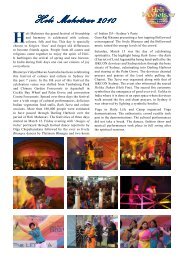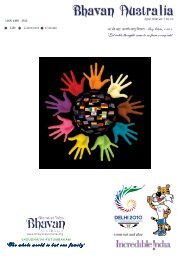Issue 8.5 - Bharatiya Vidya Bhavan Australia
Issue 8.5 - Bharatiya Vidya Bhavan Australia
Issue 8.5 - Bharatiya Vidya Bhavan Australia
You also want an ePaper? Increase the reach of your titles
YUMPU automatically turns print PDFs into web optimized ePapers that Google loves.
eginning of the Diwali celebrations and that is<br />
why, it is considered the first day of five days long<br />
festivities of Diwali. The term ‘Dhanteras’ consists<br />
of two factors ‘dhan’, which means wealth and<br />
‘teras’, which means thirteenth. Thirteenth is<br />
meant to indicate the day ‘Trayodashi’, i.e. the<br />
thirteenth day of the month on which Dhanteras<br />
falls. Dhanvantari Trayodashi (Dhanwantari<br />
Trayodashi) is celebrated on the thirteenth lunar<br />
day of Krishna Paksha, of the Hindu month of<br />
Kartik, which is two days before Diwali.<br />
Dhanteras Celebrations<br />
People worship Lord Yamaraj, the God of death, on<br />
this day and light a ‘Yama-Diya’ in the night to offer<br />
prayers to him to bless them with prosperity, wellbeing<br />
and protection. They also purchase a new<br />
utensil, silver or gold coin or some other precious<br />
metal as a sign of good luck on the day of<br />
Dhanteras. The day of Dhanteras has great<br />
importance for the mercantile community of<br />
Western India. In Maharashtra, there is a peculiar<br />
custom to lightly pound dry coriander seeds with<br />
jaggery and offer as Naivedya. In the rural areas the<br />
cultivators worship their cattle because they form<br />
the main source of their income and livelihood.<br />
Legends<br />
Another story famous about Dhanteras is related to<br />
the son of King Hima and his intelligent wife. It was<br />
predicted about King Hima that he would die on the<br />
fourth day of his marriage and the reason behind his<br />
death would be snakebite. When his wife came to<br />
know about such a prediction she decided not to let<br />
her husband die and for this she made a plan. On the<br />
fourth day of their marriage she collected all the<br />
jewellery and wealth at the entrance of her husband’s<br />
boudoir and lighted lamps all around the place and<br />
started telling stories and singing songs one after<br />
another in order to not let her husband sleep.<br />
10 | <strong>Bhavan</strong> <strong>Australia</strong> | Nov 2010<br />
In the mid night Lord Yama, the God of death<br />
arrived there in guise of a snake. The bright lights<br />
of the lamps lit by the wife of the king’s son blinded<br />
his eyes and he could not enter their chamber.<br />
Therefore, Lord Yama found a place to stay<br />
comfortable on top of the heap of the jewellery and<br />
wealth and kept sitting there for the whole night<br />
waiting to get a chance to bite the king’s son but as<br />
the wife of the king’s son kept telling stories and<br />
singing songs for the whole night therefore he<br />
could not get any chance and in the morning he left<br />
the place quietly. Thus, the wife saved her<br />
husband’s life from the cruel clutches of death.<br />
Since then the day of Dhanteras is also known as<br />
the day of ‘Yamadeepdaan’ and it has become a<br />
tradition to light a diya on Dhanteras and to keep it<br />
burning throughout the night in reverential<br />
adoration of Lord Yama, the God of death.<br />
Narak Chaturdashi (Chhoti Diwali)<br />
One famous story behind the celebrations of Diwali<br />
is about the demon king Narakasur, who was ruler<br />
of Pragjyotishpur, a province to the South of Nepal.<br />
During a war, he defeated Lord Indra and snatched<br />
away the magnificent earrings of Mother Goddess<br />
Aditi, who was not only the ruler of Suraloka, but<br />
also a relative of Lord Krishna’s wife, Satyabhama.<br />
Narakasur also imprisoned sixteen thousand<br />
daughters of Gods and saints in his harem. A day<br />
before Diwali, Lord Krishna killed Narakasur,<br />
released the jailed daughters and restored the<br />
precious earrings of Mother Goddess Aditi.<br />
Diwali and Shri Ram<br />
The most famous legend behind the celebrations of<br />
Diwali is about the prince of Ayodhya Nagri, Lord<br />
Shri Ram. According to the legend, the king of<br />
Lanka, Ravan, kidnapped Lord Ram’s wife, Sita. Ram<br />
attacked Lanka, killed Ravan and released Sita. He<br />
returned to Ayodhya with his wife Sita and younger<br />
brother Lakshamana after fourteen years.<br />
Therefore, the people of Ayodhya decorated their<br />
homes as well as Ayodhya, by lighting tiny diyas, in<br />
order to welcome their beloved prince Shri Ram<br />
and Devi Sita. It was the day of ‘Kartik Amavasyaa’<br />
when they also celebrated the victory of Shri Ram<br />
over the King of Lanka, Ravan. Ram is considered<br />
the symbol of good and the positive things and<br />
Ravan represents the evils. Therefore, Diwali is<br />
considered the festival, which establishes the<br />
victory of good over the evil. On the night of Diwali,<br />
people light diyas, an icon of positive energy to<br />
conquer darkness, the symbol of negative energy.<br />
Lakshmi Pooja<br />
Lakshmi Pooja is one of the most important<br />
features of Diwali celebrations. Lakshmi, who is<br />
considered the goddess of light, beauty, good<br />
fortune and wealth, is worshipped on the occasion<br />
of Diwali to bring prosperity in the family. She is<br />
also worshiped to achieve success and fortune. It is









